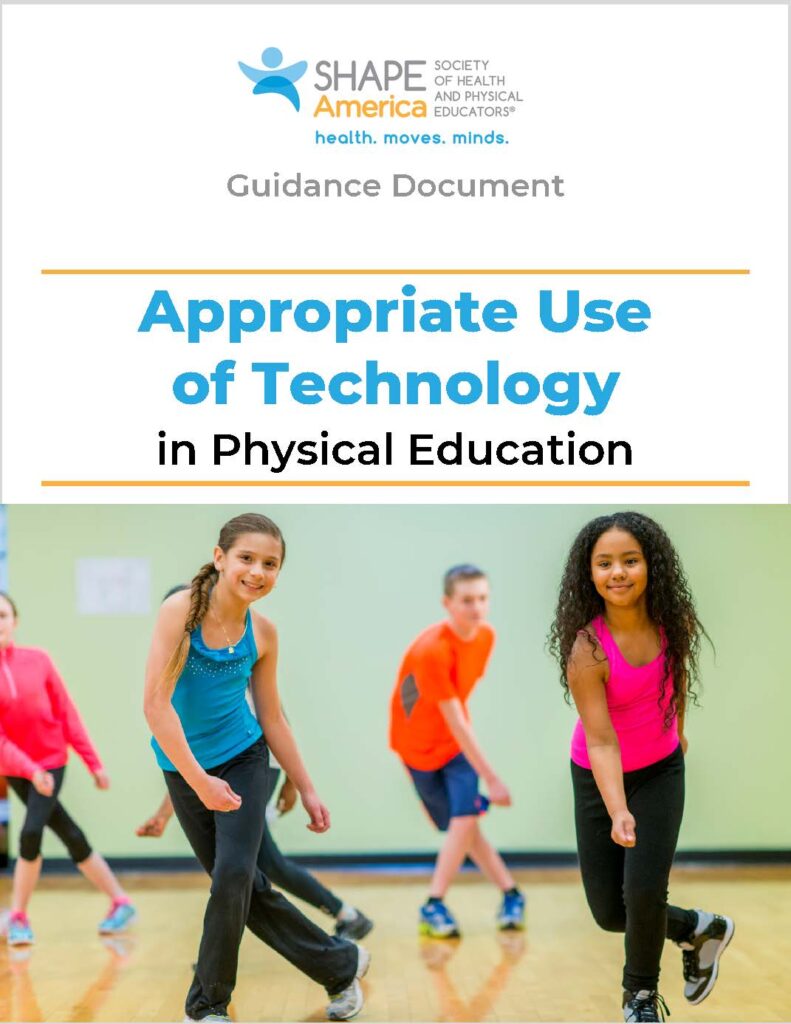
SHAPE America released a position paper this week detailing what the organization sees as “the appropriate use of technology in physical education.”
In its continued advocacy of PE as a core subject, the document encourages schools to value technology in PE the same way they value technology in other subject areas.
“Schools and districts should support the acquisition and use of technology as a means of enhancing the students’ learning in physical education to the same degree that all other content areas are supported,” the document states.
SHAPE America’s paper acknowledges that many schools already use technology in their PE programs. The organization aims to outline what it considers best practices and includes a slate of technologies that have already been successfully implemented in PE programs, including IHT’s heart rate monitor and software, which are included in SHAPE’s list of class management systems and instructional planers.
The document describes IHT’s heart rate system as an “interactive technology ecosystem that helps teachers build a student wellness portfolio daily-to-yearly, delivering heart rate data, reflective journaling, and performance metrics that can correlate to academic and social and emotional growth.”
Appropriate Uses of Technology in PE
The position paper includes 5 guidelines that teachers and schools should follow regarding using technology in the PE classroom:
- To provide a tool for learning content that is relevant to national standards, state standards and local curriculum
- To enhance instruction
- To provide opportunities for all students rather than opportunities for few
- To be an effective tool for maintaining student data related to standards-based curriculum objectives
- To enhance communication between teacher, parents, students, administration and the community.
To help teachers ensure technology meets those guidelines, the paper also includes an array of questions that teachers can ask when assessing potential technology solutions for their programs.
How IHT’s Technology Works Within the Guidelines
IHT first introduced the IHT ZONE heart rate monitor in 2016. From the first days, teachers have raved about how the monitors – and the data it delivers to students – improves motivation and empowers them to take ownership of their physical and emotional wellness.
Guideline 1: a tool for learning content that is relevant to established standards.
 Along with the heart rate monitor, IHT’s Spirit Assessments software gives teachers access to assessments – including the nationally recognized fitness tests – and rubrics that are tied to national standards.
Along with the heart rate monitor, IHT’s Spirit Assessments software gives teachers access to assessments – including the nationally recognized fitness tests – and rubrics that are tied to national standards.
“From the administration standpoint, (we liked) all that we could get into on the assessments and rubrics that were already a part of the software,” San Jose Charter School PE Teacher Matthew Bassett, the 2018 SHAPE America National Elementary PE Teacher of the Year, said. “(My administrators) were really excited about that. Things that connect to the national standards that we can use to showcase learning.”
Guideline 2: to enhance instruction.
Teachers point out that the technology helps from start to finish in class. Because they are excited to wear the monitors, students get themselves ready quickly, said Dr. Katie Harper Wright Elementary School PE teacher David Kober. The longer students take to get ready, the less time they have to wear the monitors.
“They are anxious to get them and want to start using them as soon as they get into class,” Kober said. “So I was able to use that to help with my classroom management.”
The heart rate monitor’s real-time display allows students to see exactly what’s happening throughout class. It even gives teachers a chance for mid-class mini-conferences. Students can see on the teacher’s computer screen an initial graph showing how long their heart rate measured in each zone.
“Teachers get to meet kids on a very personal and individual level and have a conversation with them about what’s going on (with their fitness),” award-winning PE teacher Doug Hallberg said. “This is real data that I can talk to kids about, that I can talk to parents about.”
Guideline 3: providing opportunities for all students
The one thing that teachers universally agree on is how heart rate monitors level the playing field for everyone in class. Teachers no longer rely on only their opinion of what they see during class to assess student performance. Data from each heart rate monitor provides teachers with almost everything they need to assess students objectively without comparing them to others.
“Knowing those ranges and being able to check those ranges as students are moving is important,” Dr. Kymm Ballard, SHAPE America’s current Past President, said. “The person who comes in first is not always the person who’s working the hardest. A lot of times, (the kid who is working the hardest) is the student who finishes last, and you can’t push them any harder.”
San Bernardino City USD PE Specialist Scott Smith used IHT ZONE heart rate monitors to revitalize his program several years ago, an effort so successful the district has since added the monitors to six additional campuses. He said the monitors proved key to changing students’ mindset toward the way they were being assessed.
“They finally felt that we were thinking about them as individuals,” Smith said. “We were not grading them against somebody else. What we were finding is that they were completely taking control of the situation.”
“It’s good, immediate feedback for the kids and it’s heart-rate specific to them,” Glen Crest Middle School (Ill.) PE teacher Kelly Nordlund said. “Regardless of your fitness level, your target heart rate zone is tailored to you.”
The technology also gave out-of-shape students a new connection to class.
“Fitness testing and in particular the PACER is a test of maximum cardiovascular effort,” Hallberg said. “The reality is, until devices like this, the (out-of-shape) kid always felt singled out. That’s horrifying to me.”
Hallberg continues to use the assessment tests, but he balances that with what he – and the student – sees on the heart rate monitor.
“I tell my students I want you to do the absolute best that you can as evidenced by you getting into the red zone,” he said. “If you get to the red zone, you are giving me everything you have at that moment, and that’s all I can ask for.”
Guidelines 4&5: to be an effective tool for maintaining student data and to enhance communication.
When he advocates for his PE program, Bassett focuses on the objective data he can share with parents and administrators. Daily reports show parents how students are working toward meeting daily goals for moderate-to-vigorous physical activity. Summary reports show administrators and other stakeholders how students are mastering standards and performing on fitness tests.
“IHT gives us a really cool program where, instead of using participation points, we can show exactly what students did and how hard they are working,” he said. “We’ll be able to show assessments to parents to show that we are hitting those national standards. It will be fun to say – and show – that we do learn things in PE.”
IHT’s software securely stores student data, and the data can follow students throughout their time in the district, allowing students to use past performance to set future goals and show student growth over time.
Used appropriately, technology has a definite role in today’s PE programs, just as it does in all other aspects of student learning. By connecting students with key elements of technology, schools can help students develop a passion for lifelong fitness.
“They are focused on their effort,” Intrinsic Charter High School PE teacher Orlandus Thomas said of students as they began using heart rate monitors. “They are improving their health. They see how the intensity of the workout pushes them to be a better, fitter, healthier version of themselves.”




